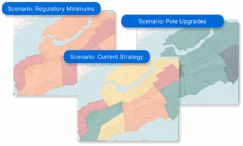How do you assess your asset management maturity?
Published on November 12th, 2024
Asset management is key to balancing costs, risks, and opportunities to optimize the performance of critical infrastructure, but its practices vary depending on an organization’s asset management maturity — the measure of how effectively assets are managed across their lifecycle.
When an organization assess their asset management maturity, they find opportunities to grow and improve, leading to holistic growth long-term.
Table of Contents
What is asset management maturity?
At its core, asset management maturity measures how well an organization manages its assets throughout their lifecycle, from acquisition to disposal.
This comprehensive approach involves more than just maintenance; it integrates planning, organizing, implementing, and controlling all asset-related activities to align with organizational goals.
Key elements of a mature asset management framework
A mature asset management framework includes policies, procedures, and tools that enable an organization to optimize asset performance, minimize risks, and achieve operational excellence.
The core components of which include:
Strategic asset management
Mature organizations align their asset management strategies with long-term objectives. These strategies ensure that every asset supports the company’s mission and contributes to sustainable success.
Being able to project 10 to 25 years into the future to see how these long-term strategies are likely to unfold is a clear indicator of a mature framework.
Proactive lifecycle optimization
By adopting proactive maintenance practices, organizations can extend the useful life of their assets and reduce unexpected downtime. Predictive technologies and data analytics play a crucial role in anticipating issues before they become costly problems.
While reactive measures are sometimes necessary, such as after severe weather events, leveraging these tools helps anticipate and meet asset needs effectively long-term.
Asset tracking and reporting systems
Accurate data is the backbone of asset management maturity.
Advanced tracking systems, or even simply a complete asset inventory, provide insights into asset performance, helping organizations make informed decisions.
Continuous improvement culture
Mature organizations foster a culture of continuous improvement, where asset management practices are regularly reviewed and enhanced.
This includes leveraging lessons learned and adapting to changing industry conditions.
Asset management technology integration
There is a wide variety of asset management technologies available on the market today. Despite the variety and availability of asset management solutions tailor-made to collect and analyze the data required to make informed, long-term decisions, too many organizations still rely on Excel to manage their assets.
Leveraging solutions like Enterprise Asset Management or Asset Investment Planning, organizations can harness insight with greater efficiency and improve the effectiveness of their asset management.
What is Asset Investment Planning?
Asset Investment Planning (AIP) can elevate an organization’s asset management maturity with advanced modeling and predictive analytivcs.
Lear more
Assessing your asset management maturity
Assessing an organization’s asset management maturity may seem complex, but The Institute of Asset Management (IAM) simplifies the process by defining clear minimum requirements for each stage of maturity, based on global expertise in asset management.
There are six stages on their asset management maturity scale, and by simply looking over the descriptions of each stage, organizations can judge where they are and where they need to go to improve their maturity.
Asset management maturity scale
Matching the descriptions and characteristics in the table of your own asset management practices will give you an assessment of your asset management maturity.
| Maturity Level | Description | Characteristics |
|---|---|---|
| Level 0: Innocent | The organization has not yet recognized the need to implement asset management practices. | Any asset management decision-making such as scheduling maintenance and selecting investments are done on an ad hoc basis. |
| Level 1: Aware | The organization has identified the need to implement asset management practices and there is intent to develop them. | Processes are reactive and overall performance is unpredictable. |
| Level 2: Developing | The organization has identified the means of systematically and consistently employing asset management best practices. | The transition to planned and documented processes has been applied within specific departments. Often a high-degree of reactivity, but in a position to achieve expected results repeatably. |
| Level 3: Competent | The organization demonstrates that it systematically and consistently achieves the relevant requirements as detailed in ISO 55001. | Processes are planned, documented, and applied within departments. However, there is limited consistency or coordination across the organization, leading to a high degree of reactivity. |
| Level 4: Optimizing | The organization demonstrates it is systematically and consistently optimizing its asset management, in line with the organization’s long-term strategic objectives. | This is a transition phase, eliminating departmental silos and increasing consistency and coordination to improve proactivity. |
| Level 5: Excellent | The organization demonstrates that it achieves the maximum value from its asset management in line with the organization’s strategic objectives. | The organization is able to look at similar, best-in-class organizations and continue to refine its standards and practices to ensure maximum value from its assets is continually achieved. |
Why asset management maturity matters
Achieving a high level of maturity offers significant benefits:
Optimized Asset Utilization. Ensuring assets operate at peak efficiency.
Reduced Downtime. Proactive maintenance minimizes disruptions.
Extended Asset Lifecycles. Delaying costly replacements through effective care.
Cost Savings. Lower operating costs and improved return on investment.
Enhanced Decision-Making. Data-driven insights lead to smarter investments.
Elevate your asset management maturity
Whether you’re just beginning your journey or looking to refine your existing processes, assessing your organization’s asset management maturity is the first step toward operational excellence. By embracing a mature framework, you’ll not only enhance asset performance but also position your organization for sustained success in a competitive landscape.
Direxyon’s Asset Investment Planning solutions can help you mature your asset management practices by: centralizing your data, standardizing your decision-making, and enabling proactive asset management.
To learn more about how Direxyon’s Asset Investment Planning can accelerate, talk to an expert today.
Let us show you how it works
Our product specialists will walk you through our proven approach to enhance your capital investment planning.

Explore resources
-
 News
NewsDIREXYON Launches GO, an AI-Powered Platform to Streamline Strategic Infrastructure Investments
Read more : DIREXYON Launches GO, an AI-Powered Platform to Streamline Strategic Infrastructure InvestmentsSelf-serve Digital Twin delivers clarity to strategic infrastructure decisions Montreal, QC, September 18, 2025 – DIREXYON Technologies today announced the launch of DIREXYON GO, a self-serve platform that simplifies and accelerates Asset Investment Planning (AIP) for municipalities and utilities. DIREXYON…
-
 E-book
E-bookTurning Wildfire Data into Smarter Investments
Read more : Turning Wildfire Data into Smarter InvestmentsYour wildfire data can do more than predict where fires may spread. It can guide the decisions that protect your grid and your communities. Wildfire threats are rising, regulations are tightening, and budgets are stretched thin. Utilities need more than…
-
 Blog
BlogWhat is Strategic Asset Management?
Read more : What is Strategic Asset Management?Strategic Asset Management is more than a buzzword. It’s a transformative shift in how municipalities and electric utilities manage infrastructure, budgets, and long-term risk. At its core, strategic asset management is about using data to make better decisions. Instead of…